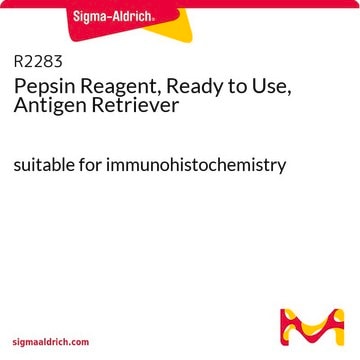The recommended solubility of this product is 1 mg/mL in 0.01N HCl. Optimum pH is 2-4. Active in 4 M urea and 3 M guanidine HCl. This is stable at 60 °C. Pepsin is irreversibly inactivated at pH 8.0 - 8.5. Enzyme solution (pepsin) – Prepare a 1 mg/mL stock solution in cold (2-8°C) 10 mM HCl. If insoluble material is present, place the stock solution on ice until dissolved. If the pepsin has dissolved, or if insoluble material is still present, after 1 hour, further dilute the 1 mg/mL stock solution to 0.01–0.05 mg/mL with cold 10 mM HCl solution.
P7000
Pepsina from porcine gastric mucosa
powder, ≥250 units/mg solid
Sinónimos:
Pepsina A, Pepsina from hog stomach
About This Item
Productos recomendados
origen biológico
Porcine gastric mucosa
Formulario
powder
actividad específica
≥250 units/mg solid
mol peso
35 kDa
Nº de acceso UniProt
aplicaciones
diagnostic assay manufacturing
Condiciones de envío
wet ice
temp. de almacenamiento
2-8°C
Información sobre el gen
pig ... LOC396892(396892)
¿Está buscando productos similares? Visita Guía de comparación de productos
Categorías relacionadas
Aplicación
Acciones bioquímicas o fisiológicas
La pepsina es la principal enzima proteolítica producida en el estómago. Digiere las proteínas mediante la ruptura de los enlaces peptídicos interiores [8].
Definición de unidad
Nota de análisis
Otras notas
Inhibidor
Palabra de señalización
Danger
Frases de peligro
Consejos de prudencia
Clasificaciones de peligro
Eye Irrit. 2 - Resp. Sens. 1 - Skin Irrit. 2 - STOT SE 3
Órganos de actuación
Respiratory system
Código de clase de almacenamiento
11 - Combustible Solids
Clase de riesgo para el agua (WGK)
WGK 1
Punto de inflamabilidad (°F)
Not applicable
Punto de inflamabilidad (°C)
Not applicable
Equipo de protección personal
dust mask type N95 (US), Eyeshields, Faceshields, Gloves
Elija entre una de las versiones más recientes:
Certificados de análisis (COA)
¿No ve la versión correcta?
Si necesita una versión concreta, puede buscar un certificado específico por el número de lote.
¿Ya tiene este producto?
Encuentre la documentación para los productos que ha comprado recientemente en la Biblioteca de documentos.
Los clientes también vieron
Protocolos
This procedure may be used for determination of Pepsin activity using hemoglobin as the substrate. It is a spectrophotometric stop rate determination.
-
Is there a favoured solvent to dissolve Pepsin from Porcine Gastric Mucosa (P7000).
1 answer-
Helpful?
-
-
How long can the enzyme be stored and mantain its activity?
1 answer-
This product does not contain an expiration date. It contains a recommended retest date of roughly two years after the quality release date. A recommended retest date is the period of time during which the product is expected to remain within established stability specifications, provided that it has been stored under defined conditions. After the Retest Date, product samples should be examined to ensure that the product is still in compliance with the established specifications. For more information you may access the "Product Dating Information" document under "ADDITIONAL USEFUL DOCUMENTS ABOUT OUR PRODUCTS" at the bottom of the Quality Services page with this link: https://www.sigmaaldrich.com/US/en/life-science/quality-and-regulatory-management/quality-services.
Helpful?
-
-
What is the Department of Transportation shipping information for this product?
1 answer-
Transportation information can be found in Section 14 of the product's (M)SDS.To access the shipping information for this material, use the link on the product detail page for the product.
Helpful?
-
-
I've seen the term "1:10000" used to define Product P7000, Pepsin from porcine gastric mucosa (Pepsin A). What does that mean?
1 answer-
A historical measurement of pepsin activity was the ratio of pepsin to coagulated egg white that the pepsin would digest. Thus 1:10,000 would refer to one part pepsin to 10,000 parts coagulated egg white. More recent analyses use hemoglobin as a substrate, in place of coagulated egg white.
Helpful?
-
-
Product P7000, Pepsin from porcine gastric mucosa (Pepsin A), can be stored at room temperature, but other pepsins are stored in the cooler or freezer. Why is this?
1 answer-
This relates to autodigestion of pepsin. P7000 is a relatively "crude" pepsin, where other proteins that are present would be more likely digestion targets. With more purified pepsin, the risk of autodigestion increases, and storage at colder temperatures reduces that risk.
Helpful?
-
-
Can I freeze stock solutions of Product P7000, Pepsin from porcine gastric mucosa (Pepsin A)?
1 answer-
Solutions of the enzyme at pH 4.4 should be stable at -20 °C for 2-3 months.
Helpful?
-
Active Filters
Nuestro equipo de científicos tiene experiencia en todas las áreas de investigación: Ciencias de la vida, Ciencia de los materiales, Síntesis química, Cromatografía, Analítica y muchas otras.
Póngase en contacto con el Servicio técnico












